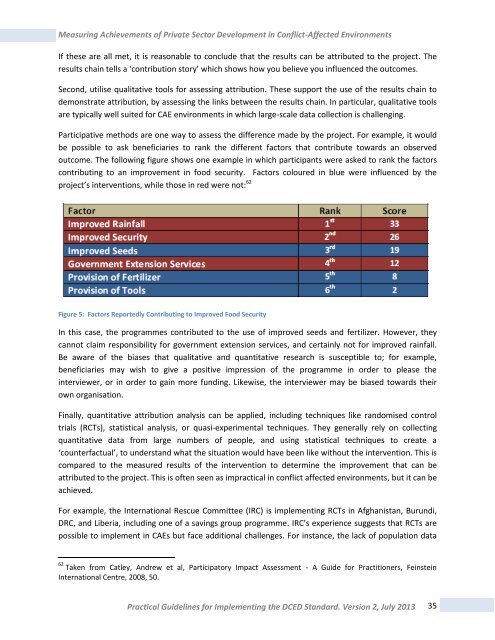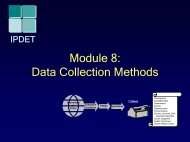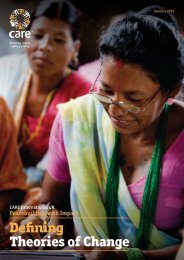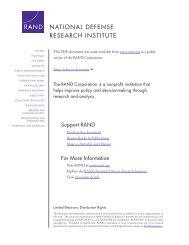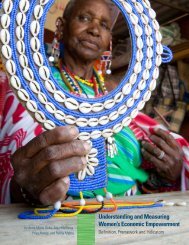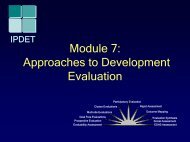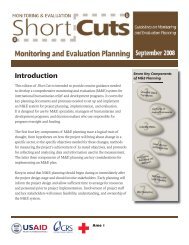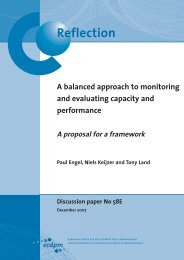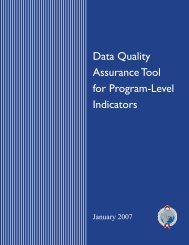Measuring Achievements of Private Sector Development in ... - DCED
Measuring Achievements of Private Sector Development in ... - DCED
Measuring Achievements of Private Sector Development in ... - DCED
You also want an ePaper? Increase the reach of your titles
YUMPU automatically turns print PDFs into web optimized ePapers that Google loves.
<strong>Measur<strong>in</strong>g</strong> <strong>Achievements</strong> <strong>of</strong> <strong>Private</strong> <strong>Sector</strong> <strong>Development</strong> <strong>in</strong> Conflict-Affected Environments<br />
If these are all met, it is reasonable to conclude that the results can be attributed to the project. The<br />
results cha<strong>in</strong> tells a ‘contribution story’ which shows how you believe you <strong>in</strong>fluenced the outcomes.<br />
Second, utilise qualitative tools for assess<strong>in</strong>g attribution. These support the use <strong>of</strong> the results cha<strong>in</strong> to<br />
demonstrate attribution, by assess<strong>in</strong>g the l<strong>in</strong>ks between the results cha<strong>in</strong>. In particular, qualitative tools<br />
are typically well suited for CAE environments <strong>in</strong> which large-scale data collection is challeng<strong>in</strong>g.<br />
Participative methods are one way to assess the difference made by the project. For example, it would<br />
be possible to ask beneficiaries to rank the different factors that contribute towards an observed<br />
outcome. The follow<strong>in</strong>g figure shows one example <strong>in</strong> which participants were asked to rank the factors<br />
contribut<strong>in</strong>g to an improvement <strong>in</strong> food security. Factors coloured <strong>in</strong> blue were <strong>in</strong>fluenced by the<br />
project’s <strong>in</strong>terventions, while those <strong>in</strong> red were not: 62<br />
Figure 5: Factors Reportedly Contribut<strong>in</strong>g to Improved Food Security<br />
In this case, the programmes contributed to the use <strong>of</strong> improved seeds and fertilizer. However, they<br />
cannot claim responsibility for government extension services, and certa<strong>in</strong>ly not for improved ra<strong>in</strong>fall.<br />
Be aware <strong>of</strong> the biases that qualitative and quantitative research is susceptible to; for example,<br />
beneficiaries may wish to give a positive impression <strong>of</strong> the programme <strong>in</strong> order to please the<br />
<strong>in</strong>terviewer, or <strong>in</strong> order to ga<strong>in</strong> more fund<strong>in</strong>g. Likewise, the <strong>in</strong>terviewer may be biased towards their<br />
own organisation.<br />
F<strong>in</strong>ally, quantitative attribution analysis can be applied, <strong>in</strong>clud<strong>in</strong>g techniques like randomised control<br />
trials (RCTs), statistical analysis, or quasi-experimental techniques. They generally rely on collect<strong>in</strong>g<br />
quantitative data from large numbers <strong>of</strong> people, and us<strong>in</strong>g statistical techniques to create a<br />
‘counterfactual’, to understand what the situation would have been like without the <strong>in</strong>tervention. This is<br />
compared to the measured results <strong>of</strong> the <strong>in</strong>tervention to determ<strong>in</strong>e the improvement that can be<br />
attributed to the project. This is <strong>of</strong>ten seen as impractical <strong>in</strong> conflict affected environments, but it can be<br />
achieved.<br />
For example, the International Rescue Committee (IRC) is implement<strong>in</strong>g RCTs <strong>in</strong> Afghanistan, Burundi,<br />
DRC, and Liberia, <strong>in</strong>clud<strong>in</strong>g one <strong>of</strong> a sav<strong>in</strong>gs group programme. IRC’s experience suggests that RCTs are<br />
possible to implement <strong>in</strong> CAEs but face additional challenges. For <strong>in</strong>stance, the lack <strong>of</strong> population data<br />
62 Taken from Catley, Andrew et al, Participatory Impact Assessment - A Guide for Practitioners, Fe<strong>in</strong>ste<strong>in</strong><br />
International Centre, 2008, 50.<br />
Practical Guidel<strong>in</strong>es for Implement<strong>in</strong>g the <strong>DCED</strong> Standard. Version 2, July 2013<br />
35


